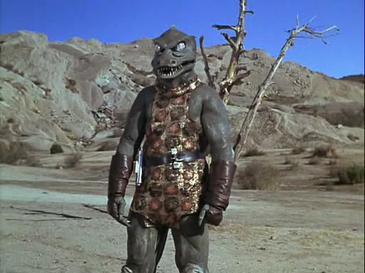Well-preserved footprints from the Lower Cretaceous Jinju Formation of South Korea, 110 million years ago, show that an ancestor of modern-day crocodiles, named Batrachopus grandis, walked on two feet.
Palaeontologists knew that some crocodiles from the "age of dinosaurs" were more adapted to life on land than their modern relatives but those were smaller creatures, about three feet long with footprints showing they walked on all fours. Batrachopus grandis was instead 12 feet in size and bipedal. It is more like a Gorn from the television show "Star Trek" than what we think of as a crocodile.
A Gorn, not
Batrachopus grandis. Image: Wikipedia
The tracks show details of skin impressions as clear as if they were made yesterday. Tracks also read the pattern of pads, showing foot bone structure and the tell-tale narrowness of trackways which show a bipedal gait, different from the sprawling posture of modern crocodiles. 
3-D image of Batrachopus grandis, the new Cretaceous crocodilian that walked on two feet. Credit: Martin Lockley
There has even been evidence from parallel trackways that show they may have traveled in social groups, just like their dinosaur cousins.
Among with the remains of some of the oldest terrestrially adapted crocodiles, are large Triassic species, more than 200 million years old, that some palaeontologists think may have been bipedal, based on anatomy. At least for the Cretaceous Period, that is true. It also proves this adaptation was effective for millions of years, even with big fierce dinosaurs running around.
The new study has also solved a tracking mystery dating back to 2012, when some poorly preserved tracks of a bipedal animal were first found in another South Korean rock unit. There was debate over whether the giant pterosaurs were bipeds, quadrupeds or possibly even pterosaurian or human.




Comments